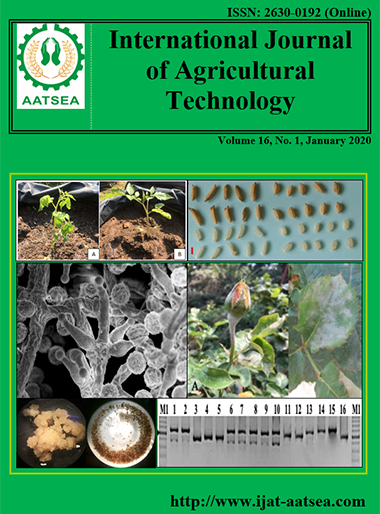Effect of sex, age and final live mass on carcass traits of fattening dairy cattle
Main Article Content
Abstract
Most animals (63.25 %) obtained a marbling score of 2 while 19.27 % obtained a score of 1. Marbling score was not affected by all the studied factors (P>0.05). Sex had a significantly stronger effect on hot and chilled carcass mass (P<0.01): averages for both hot and chilled carcass masses of males were greater than those of females. All studied traits (P<0.05), except chilling loss (P>0.05), were influenced by age. Averages of both hot and chilled carcass mass, both in kg and in proportion of animals with 3 yrs age were higher, but not statistically different from those of 4 yrs animals. Most traits were significantly affected by final live mass (P<0.01). As the final live mass increased, both hot and chilled carcass mass in kg and as a fraction increased, and chilling loss both in kg and as a fraction decreased.
Article Details

This work is licensed under a Creative Commons Attribution-NonCommercial-NoDerivatives 4.0 International License.
References
ACFS (2004). Thai Agricultural Community and Food Standard TACFS 6001-2547. Ministry of Agriculture and Cooperative, Bangkok, pp. 13.
Ardicli, S., Dincel, D. and Balci, F. (2018). Evaluation of slaughter weights and carcass traits of bulls marketed in South Marmara Region of Turkey. Harran University Journal of the Faculty of Veterinary Medicine, 7:45-50.
Barton, R. A. and Pleasants, A. B. (1997). Comparison of the carcass characteristics of steers of different breeds and pre-weaning environments slaughtered at 30 months of age, New Zealand Journal of Agricultural Research, 40:57-68.
Bazzoli, I., Marchi, M. De, Cecchinato, A., Beery D. P. and Bittante, G. (2013). Factors associated with age at slaughter and carcass weight, price, and value of dairy cull cows. Journal of Dairy Science, 97:1082-1091.
Chainam, J. and Opatpatanakit, Y. (2016). Carcass quality of culled dairy cows and fattening dairy steers raised by members of Beef Cluster Cooperative in Thailand. 62nd International Congress of Meat Science and Technology, Bangkok. Retrieved from http://icomst-proceedings.helsinki.fi/papers/2016_01_07.pdf
Ledbetter, K. (2018). Beef influence on dairy cattle could improve marketing options, bottom line. Department of Animal Science. Retrieved from http://animalscience.tamu.edu/2018/03/21/beef-influence-dairy-cattle-improve-marketing-options-bottom-line/.
Liinamo, A. E. (2000). Breeding for carcass traits in dairy cattle. (Academic Dissertation). University of Helsinki, Finland.
SAS (1999). SAS/STAT User’s Guide: Statistic, SAS Institute Inc. North Carolina.
Sawanon, S. (2012). Male dairy cattle: Possibility for bringing to produce quality beef. Kasetsart Livestock Magazine, 39:32-40.
Sethakul, J. (2016). Fattening dairy beef: the opportunity to entering in market quality beef. In Seminar of Fattening Dairy Beef: Opportunity and Preparedness in Beef Shortage Crisis. Meajo University, Chiang Mai, pp.1-7.
Supphakitchanon, T., Pattanawong, W., Kiratikrankul, B. and Chainam, J. (2015). Systemic management for quality meat production from cull dairy cow. Retrieved from https://elibrary.trf.or.th/downloadFull.asp?proid= PDG6120003.
Taylor, R. E. (1984). Beef Production and the Beef Industry. Macmillan Publishing. New York, New York.
Tuntivisoottikul, K. and Limsupavanich, R. (2018). Effects of gender of dairy or beef cattle and the number of pair of permanent incisors on carcass traits. MATEC Web of Conferences, 192:03050.
Wardynski, F. (2012). Raising dairy steer calves for profitable beef production. Retrieved from https://today.agrilife.org/2018/03/21/beef-influence-dairy-cattle-improve-marketing-options-bottom-line/.


